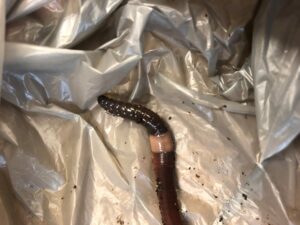Asian jumping worms, a group of invasive earthworms, have gained a significant amount of media attention in the last several weeks, and for good reason. Unlike the nightcrawlers and other earthworms we know, Asian jumping worms do not improve soil health to the benefit of plants. Instead, jumping worms (also called crazy worms, snake worms, or ‘Alabama jumpers’) almost completely strip nutrients out of soil, altering the soil structure and severely impairing the ability to develop many kinds of plants. After they are done with an area, Asian jumping worms leave behind soil that has a texture similar to that of coffee grounds and very low nutritional value. On top of this, Asian jumping worms are capable of reproducing asexually, allowing their population to grow very rapidly and making them an invasive species of some concern.
Identification

The clitellum, the set of pale, milky colored segments, is the reproductive organ of earthworms.
The good news is that Asian jumping worms are not well-suited to Indiana’s environment. They aren’t capable of surviving winters in any life stage except as an egg, meaning their activity periods are limited to late June to the first hard frost of the year. If you see worms outside of this period, it’s highly unlikely an Asian jumping worm. There are also a few traits the worms have that you can use to visually confirm their identity. First off, Asian jumping worms are accurately named; when handled, they writhe and thrash similar to snakes, setting them apart from common earthworms and nightcrawlers. Jumping worms also tend to have drier skin that has an almost iridescent appearance, as compared to the slimy, moist texture of the beneficial earthworms we need for good soil health. The most consistent feature is an organ known as the clitellum, or the reproductive organs of worms. On common earthworms, this looks like a saddle-shape that partially covers several segments, is normally reddish-brown, and is raised off the surface of the body. On an Asian jumping worm, however, the clitellum is indistinguishable from other segments, save for their pale, milky color.
Detection
There are a few options for detecting the spread of Asian jumping worms within an area. Unlike beneficial earthworms, which burrow deeply into soil and surface to feed, Asian jumping worms solely occupy the first few inches of the soil surface, meaning there’s an increased chance of finding them in that soil layer as compared to beneficial earthworms. However, the soil will need to be dug out and sifted, and any worms found would need to be identified and destroyed, resulting in a task that can be labor- and time-intensive. There is also the mustard test: mix 1/3 of a cup of ground hot mustard into one gallon of water, then pour half of the liquid over a 1 square foot area of soil. This mixture will drive earthworms to the surface, but do little to no damage to plants or soil quality. However, this mixture will affect all worms, regardless of species, so they will still need to be identified and any invasives destroyed. You can destroy Asian jumping worms you find by placing them in a sealed bag and placing it in the trash, or you can put them in a container with vinegar or rubbing alcohol.
Reporting
We are still learning about the Asian jumping worms spread in Indiana, so we are asking everyone to please report sightings. You can report them either online by going to www.eddmaps.org, www.gledn.org, or you can call 1-866-NOEXOTIC. We ask that you take a picture and tell us where you were when you saw the worms. You can also check https://ag.purdue.edu/reportinvasive for up-to-date information on all kinds of invasive species, or reach out to Bob Bruner, Purdue University Exotic Forest Pest Educator, by emailing rfbruner@purdue.edu. With your help, we can map out this worm and create effective plans to limit its presence in our state.